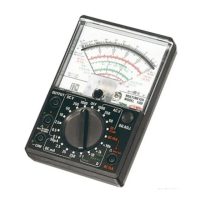6-4. Low Frequency Output (dB) Measurements
Applications:
Measuring the ratio of output to input for amplifiers, transmission
circuits, etc.
The ratio of output to input in amplifier and transmission circuits
is expressed in logarithmic values as the human sense of hearing
responds to the level of sound logarithmically. This is measured in terms
of decibels (dB). Where the load impedance of a circuit is constant two
values of power can be compared simply by indicating input to output
voltage (current) ratio in dB.
The dB readings on the scale are references to 0 (zero) dB power level
of 0.001 watt (one milliwatt) across 600 ohms, or 0.775V AC across 600
ohms. therefore, output in a 600 ohms impedance circuit can be read
directy from the dB scale. When the impedance of a measuring circuit is
not 600 ohms, however, a dB reading obtained is simply the result of
measuring an AC voltage on the corresponding dB scale.
⑴
To measure decibels, read the dB scales in accordance with the
instructions for AC voltage measurements.
⑵
For the 10V AC range read the dB scale directly (0 dB=1mW or
0.775V across 600 ohms). For other ranges including the50V range
read the dB scale and add the appropriate number of the dB to the
reading as shown on Table 2.
Table 1
AC Volt Ranges 10V 50V 250V 1000V
Add dB 0 +14dB +28dB +40dB
Max. dB +22dB +36dB +50dB +62dB

